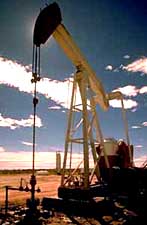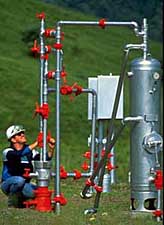Water Purity Assurances
The worst possible contamination fears related to the process of injecting noxious chemicals deep underground in the process of gas extraction in shale known as fracking appears to have been put to rest. At the very least, the process can continue to be studied and conclusions reached that will either support the initial and seemingly rock-solid conclusion reached by the U.S. Department of Energy or refute their findings. |
|
|
A "horse head" pump.
Source: API |
The chemical substances used in fracking have the potential to be extremely dangerous if they migrated upward to contaminate water aquifers. But the tests demonstrated that the substances remained roughly a mile from drinking water supplies derived from aquifers. "This is good news" said Duke University scientist Rob Jackson, not involved with the study.
 |
|
|
Natural gas from underground formations flows through pipes on the surface sometimes called a "Christmas Tree."
Photo: NGSA |
Tens of thousands of wells have been drilled recently, many located in what is called the Marcellus Shale formation located under parts of Pennsylvania, New York, Ohio and West Virginia. Fears abounded that the chemicals utilized in the drilling process to free up gas extraction could spread and contaminate vital water supplies.
The study whose results have so recently been released was performed by the National Energy Technology Laboratory in Pittsburgh. Representing the first time a drilling company agreed to allow government scientists to inject special tracers into the fracking fluid enabling monitoring to determine whether the injected fluid spread upward toward drinking water sources.
Both state and federal regulators have supported industry in its insistence that fracking itself would not contaminate surface drinking water, because of the extreme depth at which the gas wells are found and drilled. Most of those wells are over a mile deep underground. Drinking water aquifers generally are located within 500 to 1,000 feet of the Earth's ground surface.
Labels: Extraction Resources, Technology, United States

0 Comments:
Post a Comment
<< Home